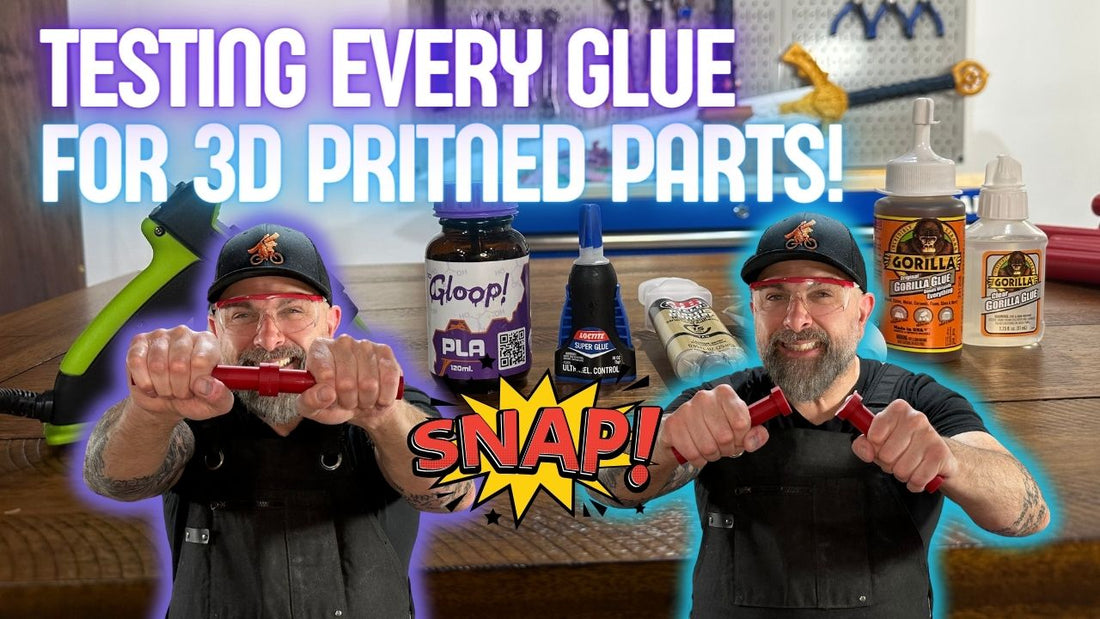The Ultimate 3D Printing Glue Test: From Super Glue to 3D Gloop
Welcome to Maker Build It! Today, we're diving into an extensive test of various glues used in 3D printing. We'll be evaluating everything from super glue to 3D Gloop, putting each adhesive through a rigorous stress test to see how they perform in real-world applications. But before we jump into the testing, don't forget to like and follow for more 3D printing insights and DIY projects.
The Importance of Choosing the Right Glue
When working with PLA or other filaments, selecting the appropriate glue is crucial for ensuring a strong and durable bond. Each type of glue has its own set of strengths and weaknesses. Our goal today is to explore these pros and cons, providing you with a clear understanding of which adhesive might be best for your projects.
Designing the Test
We designed our test to evaluate two key principles of real-life use: whether the glued parts can snap apart and whether they can twist apart. To do this, we created bike handle-like shapes for easy gripping. These shapes were printed using standard PLA at about 50% infill. Based on each glue's specific parameters, we glued these pieces together and allowed them to cure according to the manufacturer's instructions. If clamping was required, we ensured a proper bond by securely clamping the parts together.
The Glues We Tested
3D Printing Glue: Specifically designed for 3D printing filaments, 3D Gloop offers strong bonds and can fill small gaps, making the bond even stronger. However, it's more expensive than multipurpose adhesives.
Super Glue: Known for its quick setting times and instant bonds, super glue is perfect for quick assemblies and small parts. It's widely available but can be brittle.
JB Weld for Plastics: A favorite epoxy for many applications, JB Weld forms strong, durable bonds for load-bearing parts, fills gaps, and maintains strength at higher temperatures. It has a long curing time and requires mixing before application.
Gorilla Glue: This versatile adhesive provides a strong, long-lasting bond and is water-resistant, making it ideal for outdoor prints. It expands during curing, which can cause misalignment or oozing, and requires dampening parts before application. We tested both the traditional and marine versions, as well as a new clear, non-foamy version.
Liquid Nails: Known for its strength on larger surfaces and ability to fill gaps, Liquid Nails works on a variety of materials, not just plastics. It has a long curing time and can be messy, making it potentially overkill for small 3D printing projects.
Hot Glue Gun: Offering an instant bond and flexibility, hot glue guns are straightforward to use. However, they provide weaker bonds compared to other adhesives and can deform PLA due to their high temperature.
Testing Procedure and Results
We divided the test into two groups: adhesives that cure in under two hours (hot glue, super glue, 3D Gloop, and JB Weld) and those that cure in 24 hours (Liquid Nails and Gorilla Glue). Here are the results:
Hot Glue: Held well initially but came apart under stress. Twisting it showed the bond's weakness.
Super Glue: The bond held, but the PLA broke, indicating a strong adhesive. Twisting it held up well.
3D Gloop: The bond was strong, breaking the PLA instead. Twisting also held up.
JB Weld: Similar to 3D Gloop, the adhesive held while the PLA broke. Twisting showed no failures.
Liquid Nails: Despite curing for 24 hours, the bond was weak and failed both snap and twist tests.
Gorilla Glue (Traditional and Marine): Expanded significantly, causing misalignment. The bond held up under twisting but snapped apart cleanly.
Clear Gorilla Glue: Provided the weakest bond, failing both snap and twist tests easily.
Our tests revealed that super glue, 3D Gloop, and JB Weld performed the best, passing both the snap and twist tests. In many cases, the PLA itself broke rather than the adhesive bond, indicating strong performance. Liquid Nails and clear Gorilla Glue were the weakest, with Liquid Nails failing to fully cure even after 24 hours.
Choosing the right adhesive for your 3D printing projects depends on your specific needs. For quick and easy bonds, super glue is ideal. For stronger, more durable bonds, consider JB Weld or 3D Gloop. Understanding the strengths and weaknesses of each adhesive will help ensure the success of your 3D printing projects.
For more 3D printing tips, DIY projects, and maker content, make sure to like and follow Maker Build It. Keep on making!

